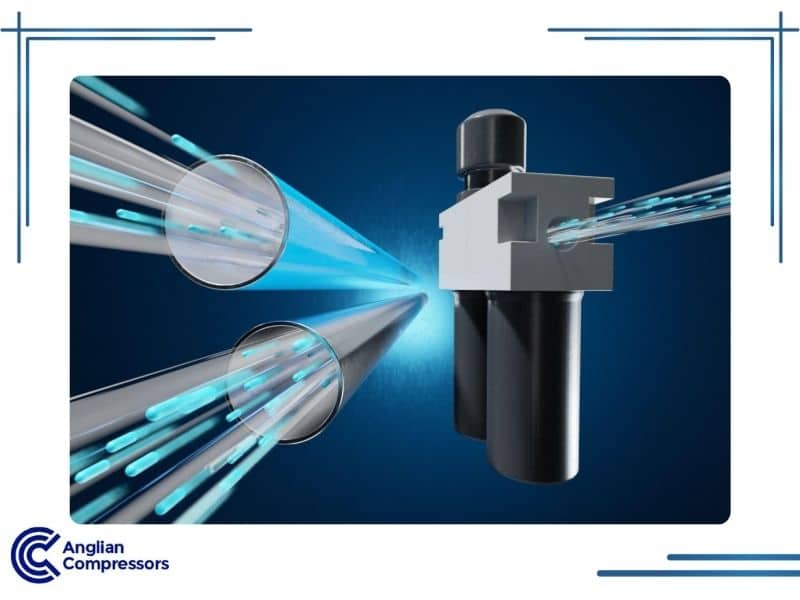A Guide to Compressed Air Piping Systems
Compressed air is an important utility in various industries. It is used to power tools, machines, and manufacturing processes. The idea behind compressed air piping systems is straightforward in theory – moving air from one place to another for devices to use the energy generated from the compressor. To achieve this, you require a good quality compressed air piping system to connect everything.
However, a poorly designed or installed piping system can lead to wastage through leaks, pressure drops, and inefficient distribution. Simply put, if your compressed air piping is not well-planned, you risk losing efficiency, time, and money.
In this comprehensive guide, we will explore the compressed air piping systems’ importance and benefits, as well as key considerations for installation. Let us have a look at how you can optimise your compressed air piping system.
The Basics of a Compressed Air Piping System
Compressed air piping systems work as the critical link between your compressor and the tools and machinery that rely on air delivered at the correct pressure and quality. A well-planned air distribution network ensures an efficient compressed air system by allowing air to pass smoothly through the pipes, minimising losses and maintaining performance.
Choosing the correct type of piping material is key to achieving optimal design. Materials with smooth internal surfaces and the proper diameter help reduce pressure drops, lower installation costs, and maintain the compressed air system’s efficiency.
Moisture management is equally important. As ambient air is compressed, water vapour can condense inside the piping used. Sloping pipes and installing moisture separators ensure the air transported remains clean and free of debris, protecting equipment and avoiding blockages.
Safety standards must also be considered. Systems should be designed to withstand operating pressures and comply with guidelines such as ISO 8573 and BCAS recommendations.
Finally, planning to design with future compressed air requirements in mind – by choosing modular piping systems and allowing for future expansion – ensures long-term savings and flexibility, while maintaining ease of installation.
Materials Used in Compressed Air Piping
Selecting the right material for compressed air piping systems is vital for performance and durability. We will look at the pros and cons of two commonly used materials in the section below.
Plastic Pipes
Plastic pipes offer several advantages over metal and their lightweight nature simplifies transportation and installation. Plastic pipes also have a smooth inner surface and are corrosion-resistant which eliminates concerns about rust contaminating the air, reduces the chance of blockages, and promotes a smooth air stream. These pipes can easily be cut and glued together offering a cost-effective and efficient alternative to welding metal pipes.
Not all plastics are suitable for the task, however. The following three plastic materials are considered the most suitable options for constructing compressed air piping.
Acrylonitrile butadiene styrene (ABS): ABS pipes are known for their exceptional strength and durability, making them well-suited for demanding industrial settings.
Polyethylene (PE): PE pipes are flexible and can endure high pressures, making them an excellent choice for underground installations and locations prone to ground movement.
High-density polyethylene (HDPE): HDPE offers exceptional resistance to chemicals and abrasion, making it appropriate for harsh operating conditions.
Metal Pipes
Metal pipes offer sturdy construction and dependable performance in compressed air pipe systems. Metal’s natural stiffness, unlike plastic, ensures it will never warp, demonstrating resilience against fractures, splits, and blowouts. Metal pipes also remain unaffected by compressor lubricants, preventing degradation.
Various metals can be used for piping air compressor systems and each has advantages and disadvantages.
Black steel: frequently chosen for its cost-effectiveness and durability, black steel piping is capable of handling high-pressure tasks. However, it might need extra coating or protection to prevent corrosion.
Galvanised steel: galvanised steel pipes feature a zinc coating that effectively fights rust and corrosion, making them great for outdoor use or in high-moisture areas.
Copper: copper pipes are excellent at conducting heat, making them suitable for applications requiring heat dissipation. Additionally, their antimicrobial properties make copper a top choice for industries with stringent hygiene needs.
Aluminium: aluminium pipes are lightweight, sturdy, and resistant to corrosion. Their modular design allows for easy installation and they minimise pressure drops, making them energy-efficient.
Stainless steel: stainless steel is a popular choice for its durability, corrosion resistance, and high-temperature tolerance. It is commonly used in demanding industries where hygiene is a prominent concern.

Designing an Efficient Compressed Air Distribution System
There are several factors that must be considered during the design process to achieve optimal performance.
Pressure Drop
Pressure drops happen when compressed air encounters resistance in pipes, fittings, and components, leading to efficiency loss and higher energy use. Carefully choosing pipe sizes, reducing bends and restrictions, and ensuring smooth interior surfaces can significantly decrease pressure drop and maximise energy efficiency.
Minimal Leakage
Minor leaks can cause substantial air loss over time, resulting in wasted energy and higher expenses. Proper installation methods, routine maintenance, and quality fittings can minimise leaks and ensure the system performs efficiently.
Proper Condensate Separation
When no compressed air dryer is installed, moisture present in the compressed air can cause corrosion, shorten equipment lifespan, and eventually have a detrimental effect on product quality. By strategically placing reliable condensate separators in the system, moisture can be removed before it reaches downstream equipment or processes.
Designing a Closed-Loop Ring Pipe System
For optimal pressure performance, air compressor installations should adopt a closed-loop ring pipe system. Branch pipes can extend to different consumption points from this main loop, ensuring a consistent compressed air supply. This design directs air to the consumption point from two directions, cutting the demand for pipe length in half.
The Importance of Including an Air Receiver in Your System
Incorporating air receivers into your system offers advantages like extra storage for peak demand and enhanced downstream stability by managing pulsations, cooling, and condensation collection from compressor cycles. Most air compressor setups incorporate one or more air receivers based on air compressor capacity, the regulation system used, and air consumption patterns.
Factors Affecting Pressure Efficiency
While designing a compressed air piping system, there are factors that have an adverse impact on pressure efficiency.
Obstructions and Blockages
Obstructions in the system can result from debris and particles accumulating in pipes, especially at connectors, valves, and devices like sensors or dryers. These can narrow pipe diameters causing pressure to drop both downstream and upstream. To prevent this, use an air filter before the air reaches the compressor and select a non-corrosive pipe material. Regular maintenance and cleaning are also needed to maintain pressure efficiency.
Moisture in the System
Moisture can cause pipe corrosion and rust, disrupting smooth air and fluid flow for compressed air delivery and application. Effective moisture control methods like desiccants, aftercooler filters, or moisture traps, are crucial to maintaining pressure efficiency.
Sharp Angles and Turns
Sharp angles can cause airflow to slow down, resulting in energy losses and reduced pressure. The turbulence created leads to a pressure drop, usually around 3 to 5 PSID, which will only get worse if the compressor’s output increases. Avoid sharp 90-degree bends and aim for gentler ones, ranging from 30 to 45 degrees, during installation.
Undersized Piping Issues
Undersized piping can hamper pressure efficiency. If the pipe size is too small for the flow rates needed, this causes more friction and reduces performance. Proper sizing is vital for optimal system operation.
Fittings in Compressed Air Systems
Fittings connect different system elements ensuring dependable compressed air flow. Quality fittings are crucial for good system performance and the durability of your compressed air system.
Below are the most common types of fittings used in compressed air systems.
Bulkhead Unions
Bulkhead unions enable convenient connections through walls or panels. These fittings offer a secure seal, preserving system integrity.
Male Elbows
Male elbows are designed to alter the direction of piping systems. They feature a male-threaded end that can be easily linked to female-threaded pipes or fittings at an angle.
Female Connectors
Female connectors, as their name implies, serve as connection points for hoses or pipes with male ends.
The Benefits of Quick-Connect Fittings
Quick-connect fittings are popular for their convenience and effectiveness, providing swift and simple connections without the need for any extra tools or expertise. They work with a push-to-connect system that securely locks the fitting, reducing the risk of leaks and enhancing system efficiency.
Quick-connect fittings also save time during installation and maintenance as they can easily be disconnected and reconnected without compromising performance and without the need for traditional threading or soldering.
Maintaining and Monitoring Your Piping System
Maintaining compressed air piping is vital to ensuring air compressor piping systems work efficiently and reliably. Without regular checks, poor piping conditions such as leaks, blockages, and corrosion can impact airflow and pressure requirements, wasting energy and damaging equipment.
Routine pressure monitoring across the network quickly identifies issues. Significant pressure drops often signal leaks or obstructions. Using tools like ultrasonic detectors and thermal mass flow meters helps detect hidden leaks and monitor abnormal consumption early.
Moisture management is also crucial. As ambient air is compressed, water is released into the compressed air, which can lead to corrosion if not properly drained. Regularly inspecting drain valves, separators, and filters helps transport the compressed air cleanly and safely throughout the system.
Keeping the pipes clean and free of debris protects downstream equipment and preserves air quality. Inline filters must be maintained and replaced when needed to avoid contamination and blockages.
Visual inspections can catch signs of wear, loose fittings, and corrosion. Planning proactive servicing around your system’s compressed air requirements helps prevent costly downtime and extends system life.
Common Challenges and Solutions
Addressing Large Pressure Drops
Consider using pressure regulators or control valves to address significant pressure drops. These tools adjust flow rates or restrict them as needed, maintaining steady system pressure. This safeguards equipment and processes by ensuring sufficient air supply without sacrificing performance.
Compensating for High Air Demand
Meeting high air demand is a common challenge in pneumatic systems when many components require compressed air simultaneously. Consider larger compressors or storage tanks to store excess air during low demand. This ensures peak demand can be met without causing excessive strain on the system.
Calculating Mean Consumption
Calculating mean consumption is vital for estimating energy costs and improving system efficiency. This involves finding the average compressed air used over a specific period. Flow meters used at critical points can accurately measure airflow rates. Aim for 20-30 ft/sec air velocity to reduce pressure drop. To size your piping system, factor in the required operating pressure – max cubic feet per minute – and distance from the air compressor to the farthest point at which the compressed air is needed.
This calculation requires a machine list with air consumption data and expected utilisation factors. If the data is not available, standard values from lists can be used. Estimating tool utilisation factors can be difficult, so compare calculated values with actual consumption in similar applications. Analysing this data helps to calculate the mean consumption and identify areas for energy-saving improvements.
Conclusion
Compressed air is crucial in many industries for tasks like operating tools and machines, and an effective compressed air piping system is vital for industries dependent on compressed air. If your piping system is not well-designed or is improperly installed, this valuable resource can be wasted through leaks, pressure drops, and inefficient distribution. Regular maintenance enhances performance and saves costs by preventing minor issues from becoming major problems. Prioritise proper checks and maintenance for your system; it is an investment that will more than pay off in terms of productivity, safety, and long-term reliability.
FAQ
How can I ensure my air compressor piping systems work efficiently over time?
Regular inspections and maintenance are crucial. Monitoring pressure levels, detecting leaks early, and keeping the pipes clean and free of debris help maintain consistent airflow and meet pressure requirements. A well-maintained system also reduces energy costs and prevents avoidable repairs.
Why is it vital to monitor moisture released into the compressed air?
Moisture released into the compressed air can lead to corrosion, blockages, and damage to downstream equipment. Regularly checking drain valves, moisture separators, and filters ensures the air transported through the piping remains dry and free of contamination.
What happens if compressed air piping is not properly maintained?
Poor piping maintenance can cause pressure drops, leaks, and contamination, which compromise system performance and reliability. Since compressed air piping is vital to efficient operations, proactive monitoring and servicing based on airflow and pressure requirements are essential to keep your system running optimally.


